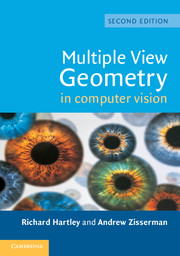Book contents
- Frontmatter
- Contents
- Foreword
- Preface
- 1 Introduction – a Tour of Multiple View Geometry
- PART 0 The Background: Projective Geometry, Transformations and Estimation
- PART I Camera Geometry and Single View Geometry
- PART II Two-View Geometry
- PART III Three-View Geometry
- PART IV N-View Geometry
- PART V Appendices
- Bibliography
- Index
PART 0 - The Background: Projective Geometry, Transformations and Estimation
Published online by Cambridge University Press: 25 January 2011
- Frontmatter
- Contents
- Foreword
- Preface
- 1 Introduction – a Tour of Multiple View Geometry
- PART 0 The Background: Projective Geometry, Transformations and Estimation
- PART I Camera Geometry and Single View Geometry
- PART II Two-View Geometry
- PART III Three-View Geometry
- PART IV N-View Geometry
- PART V Appendices
- Bibliography
- Index
Summary
Outline
The four chapters in this part lay the foundation for the representations, terminology, and notation that will be used in the subsequent parts of the book. The ideas and notation of projective geometry are central to an analysis of multiple view geometry. For example, the use of homogeneous coordinates enables non-linear mappings (such as perspective projection) to be represented by linear matrix equations, and points at infinity to be represented quite naturally avoiding the awkward necessity of taking limits.
Chapter 2 introduces projective transformations of 2-space. These are the transformations that arise when a plane is imaged by a perspective camera. This chapter is more introductory and sets the scene for the geometry of 3-space. Most of the concepts can be more easily understood and visualized in 2D than in 3D. Specializations of projective transformations are introduced, including affine and similarity transformations. Particular attention is focussed on the recovery of affine properties (e.g. parallel lines) and metric properties (e.g. angles between lines) from a perspective image.
Chapter 3 covers the projective geometry of 3-space. This geometry develops in much the same manner as that of 2-space, though of course there are extra properties arising from the additional dimension. The main new geometry here is the plane at infinity and the absolute conic.
Chapter 4 introduces estimation of geometry from image measurements, which is one of the main topics of this book.
Information
- Type
- Chapter
- Information
- Multiple View Geometry in Computer Vision , pp. 23 - 24Publisher: Cambridge University PressPrint publication year: 2004
